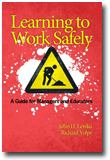
Learning to Work Safely
A Guide for Managers and Educators
By:
John Lewko, Laurentian University
Richard Volpe, University of Toronto
Published 2009
Working for pay is a common experience throughout North America for youth, with up to 80 percent of high school students working for at least a short duration of time through the course of a year. Once adolescents enter the labor market, they usually continue working, though they change jobs frequently through to their early 20s. Most working youth are employed during both the school year and the summer. Adolescents and young adults are exposed to a variety of workplace risks and hazards that include operating dangerous tools, machinery, and vehicles; handling cash in situations prone to robbery; and working with supervisors and co-workers whose own "safe work practices" are suspect. Proper orientation and training is sometimes minimal; supervision can be limited and of questionable quality. Given that over the past fifty years the proportion of adolescents entering the workforce has increased six-fold for both males and females, and that the number of working youth is expected to continue increasing due to globalization and diffusion of new technologies, there is definite cause for concern. Why the large discrepancy between young people and adults when it comes to workplace injury? Why are our future workers being injured at all? Youth willingly enter work settings expecting to be guided and protected, yet many are exposed to work environments and safety cultures leading to quite different outcomes. Some answers may lie in better understanding the young worker experience or in the similarities and differences between the young worker and adult worker experience. We only know that a simplistic, rote answer will not suffice, especially when young people continue to be injured, some fatally, on the job.
In an effort to begin answering some of these questions, we have developed this two part book. Part I is designed to provide the reader with an overview of what we know about young workers and some of the factors that may influence their ability to stay safe at work. The literature draws attention to areas ranging from The Nature of the Workplace, to Risk Perception, and finally to Management and System Support. Where appropriate, the findings from the Young Worker Young Supervisor (YWYS) project are brought into the existing literature on young worker health and safety. Part I sets the tone for Part II of the monograph by giving the reader an idea of what young workers find themselves facing when they enter the world of work, from characteristics of the workplace to unique conditions and relationships of young workers.
To further illuminate the issues and situations youth face in the workplace, Part II presents a series of vignettes that were drawn from real life situations observed through the course of the YWYS project. The vignettes are brief, evocative descriptions, accounts, or episodes representing the types of experiences common to young workers. These vignettes are based on the case studies and interviews conducted during the course of the YWYS project. The circumstances presented in the vignettes reflect the conditions under which many young workers find themselves. As farfetched as some of the managers' and young workers' behavior may seem in the vignettes, the events are fictionalized versions of real workplace occurrences. Each vignette is followed by one or more "scenario(s)", each presenting an open-ended problem taken from real life and faced by young workers. Each scenario ends with a series of questions intended to encourage the reader towards further discussion.
-
Paperback978-1-60752-081-8
Web price: $45.04 (Reg. 52.99)
-
Hardcover978-1-60752-082-5
Web price: $80.74 (Reg. 94.99)
- eBook9781607521907

-
 (Re)Envisioning Social Studies Education Research
Current Epistemological and Methodological Expansions, Deconstructions, and Creations
(Re)Envisioning Social Studies Education Research
Current Epistemological and Methodological Expansions, Deconstructions, and Creations
-
 Affirming Identity, Advancing Belonging, and Amplifying Voice in Sororities and Fraternities
Affirming Identity, Advancing Belonging, and Amplifying Voice in Sororities and Fraternities
-
 Effective Alternative Assessment Practices in Higher Education
Effective Alternative Assessment Practices in Higher Education
-
 Expanding the Vision of Faculty Learning Communities in Higher Education
Emerging Opportunities for Faculty to Engage Each Other in Learning, Teaching, and Support
Expanding the Vision of Faculty Learning Communities in Higher Education
Emerging Opportunities for Faculty to Engage Each Other in Learning, Teaching, and Support
-
 Institutional Diversity in American Postsecondary Education
Institutional Diversity in American Postsecondary Education
-
 Promoting Equitable Classroom Practices in Higher Education
Approaches Beyond Curriculum
Promoting Equitable Classroom Practices in Higher Education
Approaches Beyond Curriculum
-
 The Handbook for Aspiring Higher Education Leaders
The Handbook for Aspiring Higher Education Leaders

